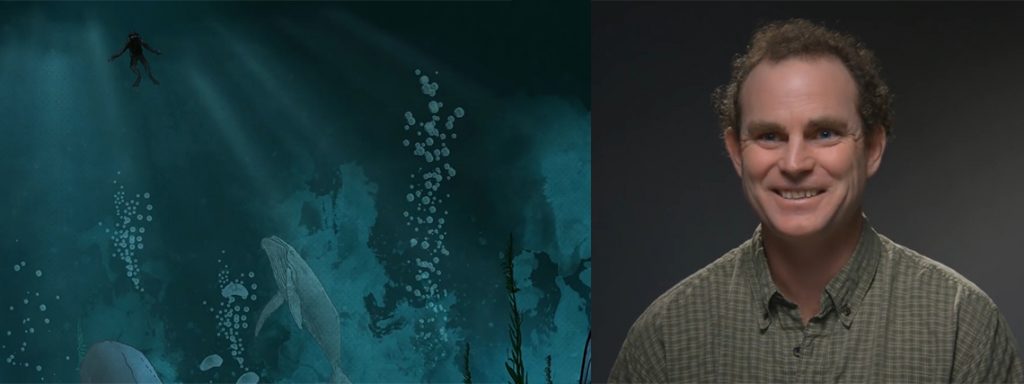The excerpt featured is from the book “Great Bear Wild,” available for sale in our store.
A Quiet Ocean | Great Bear Wild | Ian McAllister
I slip into the ocean. My dry suit and body vibrate with the otherworldly sound of humpback song. I can actually feel the whales’ song. I adjust my mask, check if the underwater housing is watertight, and begin peering around. I can see nothing except long columns of silver light reaching down into the abyss. The haziness and depth are disorienting. I will never get used to the feeling of being suspended above what seems like bottomless black water. Soon the reef face comes surging in, and suddenly with a push from the swell, bull kelp fronds embrace me for a moment. I find the anchor chain and follow it down to ensure that the steel hook is properly attached. It will hold for a while.
The ebb and flow of the surge bring me over to the more comforting rock. These outer coastal pinnacles are superbly divine in color, life, and wildness. A sheen of pink coral covers the rocks, decorated by sea slugs, spiders, giant white Metridium anemones, purple urchins, rock scallops, tube worms, and countless other species—truly countless. There is so much life here; any small section of this reef’s bottom could be scrutinized for hours and yet more critters and species would emerge. Here on this reef are exotic and diverse species writhing in iridescent colors and alien shapes. This view would easily astound any human being, but too often we behave like it doesn’t exist.
I am getting cartwheeled by the surge and current that is still running at a few knots. It feels like space travel over a new planet below: worlds of life are streaming past, nothing resting for long. There are over four hundred species of fish on the BC coast, and many of them are present here. So often when I descend, especially in the winter, to over thirty meters (one hundred feet), things are just starting to get interesting. There are fields of cod slowly moving back and forth in the deep-water surge; many of these species appear to be in a state of dormancy from the cold water and lack of food.
The famed underwater explorer Sylvia Earle estimates that we have mapped only 5 percent of the world’s ocean environments; we know more about the solar system. Thomas Peschak refers to the ocean—and our lack of understanding of it— as a mirror. We stare from above into the silvery waters and just see our reflections. It is an apt metaphor because the harm we are doing to the oceans ultimately harms our own species. Somehow we have to break through the surface sheen and understand, or at least respect, what this underwater world is about.
While I adjust my camera settings I notice the humpback whale vocalizations getting louder. If I knew more about the humpback’s complex language I might rearrange my future plans. Like an orchestra of giants, the long calls resonate between galactic groans and something akin to the music of wind and brass instruments. The sounds are delivered with clarity and purpose, but are utterly foreign. They run over and through me, then bounce off the rock wall and back again—louder and louder. I listen to the echoes: one, two, three, four, then five, before the sound is picked up and started anew. A disoriented school of herring streams past and we compare notes on who is more scared. The calls are turning into the vocalization associated with bubble-net feeding behavior.
The calls are pushing a mass of shiny blue and silver pilchards, bigger than the herring that just passed by. Looking down I can see the black balls moving like slow-running ink as they rotate in a synchronized pattern. One would think scattering would be a better defense strategy against this gang of whales—given what is coming—but each one of these little forage fish clearly feels that safety will be found deep in the confusion of a homemade fish ball, increasing in size by the second. It is mesmerizing.
I am already feeling disoriented and the pilchards’ frenzy does not help. Noting the direction of the silver stream of bubbles exhaled from my regulator is all that keeps me upright. The calls get louder and the pilchards cling together in a tighter and tighter revolving ball, circling and circling.
I see a whale moving slowly facedown below me, then another off to my left. I forget to breathe: it is so beautiful. I have to keep thinking about the current, which is picking up. It is becoming work to stay in the lee of the reef, but this is no time to swim away. The pilchard ball is revolving like a planetary orb, spinning one way but traveling the other. A picture might be in the works.
As I look through the viewfinder, my suit suddenly feels like it is being ripped open, or maybe as though a failed high-pressure hose is coming off my tank. I am engulfed in a wall of bubbles pushing me to the surface. I hold the camera tightly and swim through them to the side. The bubbles are coming from the whales deep below. I am being hit by a massive net of air designed to trap the mass of pilchards. I am staring into the open jaws of a group of whales—each one about the weight of five hundred people.
I push hard toward the rock wall, pulling on kelp as I emerge through the surface. Off to my right the whales also surface, jaws massively agape with writhing little silver pilchards, glittering like shards of glass. The wake from the surfacing whales covers me; I have seen enough.

This Underwater Photoshoot Almost Ended In The Belly Of A Whale
The excerpt above is written by our Executive Director, Ian McAllister, from the book Great Bear Wild. The featured animated Storyteller episode of Ian recounting an underwater photoshoot which almost ended in the belly of a whale, is presented by the Banff Mountain Film and Book Festival.
Buy Great Bear Wild here

